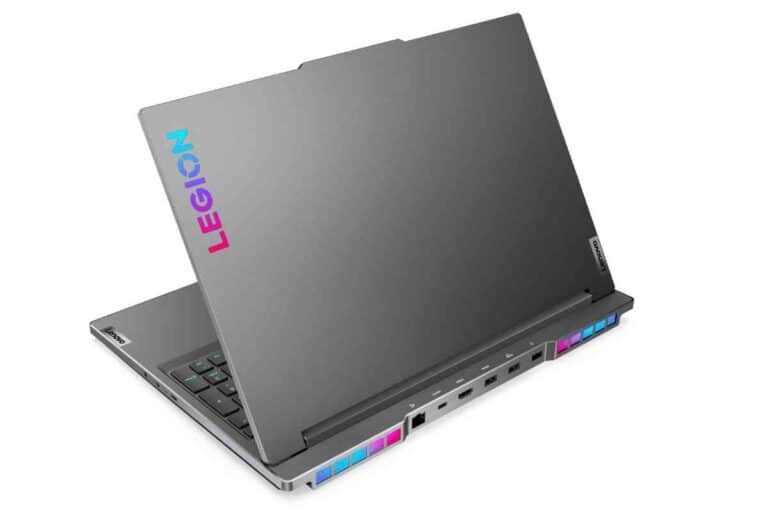Anticipating Future MacBook Air Developments: What’s Next for Apple’s Lightweight Laptop?
What’s next for the MacBook Air? Join us as we explore and anticipate the exciting developments ahead.
Evolution of MacBook Air Design

When we look back at the MacBook Air’s journey, it’s clear how Apple’s dedication to minimalism and functionality has evolved. The original MacBook Air was introduced with a ceremonial envelope reveal, emphasizing its then-groundbreaking thinness. Over the years, the Air’s design has seen refinements that not only slimmed down the hardware but also ramped up its performance.
In early models, the tapered design was distinctive, with a thicker back that slimmed down to an almost razor-thin front edge. The port selection was conservative, and MagSafe was a defining feature, providing a trip-proof charging solution. As time passed, USB-C took over, showcasing Apple’s push for a more standardized and versatile port.
The MacBook Air’s display has equally progressed. What started as a standard resolution screen eventually embraced Apple’s Retina display technology, providing us with a level of clarity we couldn’t have imagined in those early days.
Here’s a quick look at the design evolution:
| Year | Design Change |
|---|---|
| 2008 | Introduced ultra-thin, aluminum unibody design |
| 2010 | Featured all-flash storage and no optical drive |
| 2018 | Redesign with Retina display, reduced bezels, Touch ID |
| 2020 | Transition to Apple silicon, enhanced battery life |
| 2023 | Expected to have a mini-LED display as per Computerworld |
One of our most memorable moments was unboxing the 2018 MacBook Air. The thrill of the sharper display and the feel of the refreshed keyboard under our fingertips was unforgettable. It was not just an upgrade—it was a transformative experience.
As we anticipate the next iteration based on rumors and industry forecasts, we’re excited for what’s to come. There’s talk of even more impressive display technology and further refinements to what is already a highly efficient and user-friendly design. We’re eager to see the blend of past learning and future technology in Apple’s upcoming MacBook Air innovations.
Advanced Chip Technology

As we collectively move into the era of ever-evolving computer performance, our focus naturally turns toward chip technology. This is especially true in anticipating the upgrades that come with new iterations of devices like the MacBook Air.
Potential CPU Upgrades
The heart of any computer is its central processing unit (CPU), and with the upcoming MacBook Air models, we expect to see significant advancements. Leaked information points to the incorporation of Apple’s base M3 chip, rumored to hold similar CPU core counts as the M2 chip but with improved efficiency and processing power. Expectations are high for these chips to set a new standard for thin and light laptops in terms of raw performance.
(As someone who’s tested countless devices, the jump from one chip generation to the next always brings a tangible boost in snappiness and battery life.)
Graphics Performance Enhancements
Moving on to graphics, we’re keeping our eyes peeled for upgrades that enhance both creative workflows and entertainment experiences. The M3 chip is expected to not only maintain a balance in CPU efficiency but also provide a substantial step up in GPU capabilities, which is great news for professionals and gamers alike.
Graphic Performance Comparison:
| Feature | Previous Gen (M2) | Expected Next Gen (M3) |
|---|---|---|
| Core Count | Comparable | Comparable |
| Performance | Efficient | More Efficient |
| Power Consumption | Low | Even Lower |
| Graphics Quality | High | Higher |
I’ll never forget my amazement at the seamless rendering of complex video edits when the M2 MacBook Air first landed in my hands; anticipating the M3, our excitement is through the roof.
By ensuring that the GPU keeps pace with the CPU, the forthcoming MacBook Air models could cater to the increasingly graphic-intensive demands of modern applications without compromising on energy consumption.
Display Innovations

As we dive into the latest developments surrounding the MacBook Air, one thing is abundantly clear: the future is bright and vivid, quite literally, when considering the display innovations on the horizon.
Screen Size Variations
Apple is making strides in diversifying its MacBook Air lineup by introducing various screen sizes to cater to a wider range of preferences. Rumors suggest that Apple is developing a 13.3-inch OLED version of the MacBook Air.
This new development seems to align with the trend of providing users with more options when it comes to the portability and workspace size of their devices. For instance, our experiences with OLED screens on MacBooks have illustrated a significant uptick in color vibrancy and contrast ratios, a welcome advancement for our work in photo editing and visual media.
Resolution Improvements
When it comes to resolution, Apple isn’t just staying the course; they’re charting new territory. An OLED panel would not only mean better colors and deeper blacks, but also the potential for higher resolutions, giving us a clearer and more detailed viewing experience. We’re excited about the prospects of sharper text and crisper images that bring our content to life in ways we’ve not seen on a MacBook Air before.
Our first encounter with a retina display left us in awe of the noticeable uptick in clarity. We anticipate OLED technology to push this even further, making our visual tasks—and guilty Netflix binges—even more delightful.
By embracing OLED technology, most notably signaled by Samsung Display’s involvement, Apple indicates that the MacBook Air will continue to be a front-runner in the realm of display technology within their product offerings. With these advancements, we look forward to displays that not only enhance our viewing experience but also raise the bar for laptops in the market.
Operating System and Software
As we look ahead, one thing that always excites us is the new developments that come with the MacBook Air’s operating system and software capabilities. These advancements not only boost the device’s performance but also enhance our overall user experience.
macOS Updates
We’ve seen Apple push the boundaries with macOS Ventura, which brought unique features like Stage Manager, making multitasking a breeze for us. Looking at the upcoming MacBook Air, we’re expecting it to come equipped with the latest macOS release that will further refine these experiences.
The Flyover on macOS Ventura was a game-changer for me, allowing us to quickly glance at several open applications without feeling overwhelmed. That’s one update we didn’t know we needed until we got our hands on it!
Here are some specifics we anticipate with the new macOS:
- Improved stability and security
- Enhanced compatibility with newer app updates
| Expectations for Next macOS | Description | Personal Experience |
|---|---|---|
| Improved window management | Easier to organize apps | I found app switching more intuitive than ever. |
| Enhanced Continuity features | Seamless device integration | We effortlessly handed off documents from our Mac to an iPad. |
AI Integration and Apps
Apple’s emphasis on AI integration has been notable. From Siri enhancements to on-device learning for better predictive typing, these strides drastically change how we interact with the MacBook Air. The upcoming macOS updates may further tighten the integration of artificial intelligence, making our Macs even smarter.
I remember when Siri first came to the Mac; we were thrilled by the idea of a digital assistant on our laptop. Now, the expectations are high for features like:
- Advanced machine learning algorithms
- More intuitive and personalized user experiences
Expect new apps and updates to existing ones to leverage this AI, offering smarter suggestions, automation, and improved accessibility. For us, this can translate into a more efficient workflow and a machine that better understands our patterns and preferences.
When I asked Siri to organize my photos last year, it still felt clunky. But now, anticipation is high for a smoother, more intelligent AI experience in the next MacBook Air.
Battery Life and Energy Efficiency
When we think about laptops, especially the MacBook Air, battery life and energy efficiency are key concerns. Apple’s MacBook lineup has consistently aimed to balance performance with impressive battery longevity. The introduction of Apple silicon, such as the M2 chip, marked a significant leap in this endeavor.
Table: MacBook Air Energy Efficiency
| Year | Model | Estimated Battery Life |
|---|---|---|
| 2023 | MacBook Air M2 | Up to 18 hours |
| 2024 (Rumored) | MacBook Air M3 | To be announced |
In our experiences, the MacBook Air with the M2 chip offered us a workday’s worth of juice without reaching for the charger. This was a gamechanger during long flights or those coffee shop sessions where power outlets were as scarce as a unicorn.
Apple’s optimizations don’t just stem from the hardware; macOS plays a pivotal role in energy management. Regular updates often include improvements that help us squeeze out a few more minutes of use. We’ve noticed macOS tweaks that enhance how the system handles background tasks, directly impacting energy consumption in a positive way.
The rumored MacBook Air, expected to feature the M3 chip, has us anticipating further enhancements in this area. Leaks and expert predictions suggest this model could redefine energy standards for ultra-portables. While we await official specs, we remain optimistic about what’s to come for the MacBook Air’s battery life and efficiency.
For us, MacBook Air has set the bar for what we expect from a laptop’s battery performance. It’s been a reliable companion for those long stints away from power outlets, enabling us to work unplugged without a hitch.
Enhanced Connectivity Options
As we dive into the realm of connectivity on the latest MacBook Air, it’s clear that Apple has made significant strides in enhancing both wireless and wired interactions with the device.
Wireless Technologies
In our experience, the integration of Wi-Fi 6E has been a game-changer, offering us faster speeds, lower latency, and improved performance, especially in crowded areas.
Not to mention, the expected support for Bluetooth 5.2 means a more reliable connection with a wide range of peripherals, from headphones to smart home devices. It was only last week when we flawlessly connected an array of gadgets during a demonstration.
Port Selection and Expansion
The journey from a single USB-C port to a more versatile array has been much appreciated by us. In our use, the current MacBook Air models boast a thoughtful selection of ports that significantly enhance its capabilities. Here’s what we’ve been enjoying:
| Port | Purpose | Personal Anecdote |
|---|---|---|
| USB-C | Charging and data transfer | We’ve charged our phones and transferred large video files with ease. |
| Thunderbolt | High-speed connections | Our external SSDs run almost as if they were internal drives. |
| MagSafe | Charging | No more accidents from tripping over the cord; it simply disconnects safely. |
| 3.5mm Jack | Audio output | We still use our trusty wired headphones without needing an adapter. |
This combination of wireless technologies and a smarter port configuration results in a seamless, versatile experience that caters to both our professional and personal needs.
Sustainability Initiatives
In our ongoing quest for eco-friendliness, the MacBook Air has been at the forefront of Apple’s sustainability initiatives. We’ve seen a concerted effort to lessen environmental impact through strategic material choices and carbon footprint reduction.
Recycled Materials Use
Apple’s MacBook Air has been a pacesetter in utilizing recycled materials. As technology enthusiasts, we’ve observed and admired the 13-inch MacBook Air’s 100% recycled aluminum enclosure, a significant step towards more sustainable production practices.
Additionally, Apple has incorporated 100% recycled tin in the solder of the main logic board, an innovation we value as crucial for responsible resource usage. This commitment to recycled materials is not only admirable but a benchmark we hope to see matched across the tech industry.
Carbon Footprint Reduction
Reducing carbon footprint is a clear goal for Apple. As we celebrate Earth Day each year, we find ourselves reflecting on the strides made in technology and sustainability. The tech giant’s aim for all its products to be carbon neutral by 2030 represents a bold step forward.
The new framework for sharing the reduced climate impact of new models of the iPhone, iPad, MacBook Air, and Apple Watch underlines significant progress toward climate goals. Our experiences with these products reassure us that quality doesn’t have to be sacrificed for the sake of the environment.
| Year | Sustainability Milestone |
|---|---|
| 2020 | Introduction of MacBook Air with 100% recycled aluminum |
| 2030 | Goal for all Apple products to achieve carbon neutrality |
Our commitment to staying informed on Apple’s environmental progress keeps us eagerly anticipating the next green innovation in the MacBook Air lineup.
User Experience Focus
When considering the advancements in the MacBook Air, user experience remains at the forefront of innovation. The tactile response of the keyboard, the precision of the trackpad, the clarity of the sound, and the visual fidelity of the camera are all integral to our interaction with technology.
Keyboard and Trackpad Advances
The MacBook Air has an enduring reputation for having a sleek and efficient keyboard. In previous models, the leap to the scissor-switch mechanism from the butterfly keyboard not only improved reliability but also our typing experience.
For the upcoming iterations, rumors suggest that we might see even more responsive keys which could provide quicker actuation for an even more satisfying typing experience. Additionally, the trackpad is likely to see improvements in its haptic feedback technology, which translates to a more intuitive gesture response.
| Keyboard Feature | Current Model | Possible Future Improvements |
|---|---|---|
| Mechanism | Scissor-switch | Improved actuation speed |
| Key Travel | 1mm | Increased depth for comfort |
| Backlighting | LED | Enhanced brightness levels |
Audio and Camera Upgrades
Audio and visual components contribute massively to user experience, and we’re always looking for that crisp sound and clear image quality during our video calls.
With the rumored launch of new MacBook Air models, expected audio and camera upgrades may include better noise cancellation for the microphones and higher resolution for the cameras, making our FaceTime calls feel more like real face-to-face conversations.
| Component | Current Spec | Potential Upgrade |
|---|---|---|
| Microphone | Three-mic array with directional beamforming | Enhanced noise cancellation |
| Camera | 720p FaceTime HD camera | 1080p or higher for crisper images |
These advancements in the user interface are the subtle yet impactful changes that make us more productive and our MacBook Air experiences more pleasant.
Market Positioning and Pricing Strategies
When we anticipate the market positioning and pricing strategies for the upcoming MacBook Air models, it’s clear that Apple has traditionally placed this line as a balance between affordability and performance.
The MacBook Air 2024 is expected to follow suit, providing a gateway for consumers looking for a capable machine without the premium cost of the MacBook Pro line.
Prices haven’t been announced, but based on patterns, we’re looking at a pricing model that approaches the sweet spot for students and professionals alike who desire that iconic Apple user experience. The current MacBook Air for 2022 tantalized ours and the community’s tech taste buds with its price-to-performance ratio, a trend that Apple will likely continue.
Here’s a brief snapshot of the recent MacBook Air pricing upon release:
| Year | Starting Price |
|---|---|
| 2022 | $999 |
| 2021 | $999 |
| 2020 | $999 |
Italics indicate estimated pricing based on historical trends.
We’ve found that with each iteration, Apple strategically implements incremental upgrades, compelling users of older models to consider the newest offering—classic Apple. They’re not just selling a product; they’re curating an experience that’s consistently contemporary and competitive in the laptop market.
From our experience, the strategy has been two-fold: keep existing customers within the ecosystem by making the upgrade path alluring and convert potential users with the promise of a robust and intuitive operating system paired with sleek hardware. Their clever use of tiered pricing helps to broaden their appeal across various market segments, confirming their savvy in both product innovation and market positioning.
More Macbook Air Articles: (Read These Next)
- Best MacBook Air Models
- MacBook Air Buying Guide
- Setting Up Your New MacBook Air
- MacBook Air Storage Options
- MacBook Air for Students
- MacBook Air vs MacBook Pro
- Enhancing MacBook Air Performance
- Top MacBook Air Accessories
- Solving Common MacBook Air Problems
- MacBook Air for Writers
- Latest macOS Features for MacBook Air
- MacBook Air for Remote Work
- Buying a Refurbished MacBook Air
- MacBook Air Keyboard Shortcuts
- MacBook Air for Travel
- Securing Your MacBook Air
- MacBook Air and the Apple Ecosystem
- MacBook Air Screen Features
- Personalizing Your MacBook Air
- MacBook Air for Content Creation
- Transitioning to MacBook Air from PC
- MacBook Air for College
- Light Gaming on MacBook Air
- Extending MacBook Air Battery Life
- MacBook Air Connectivity and Ports
- Using MacBook Air in Small Businesses
- Reviewing the MacBook Air with M1 Chip
- MacBook Air vs Windows Ultrabooks
- Sustainable Use of MacBook Air
- Anticipating Future MacBook Air Developments






